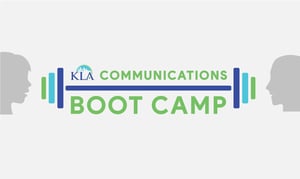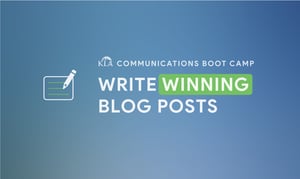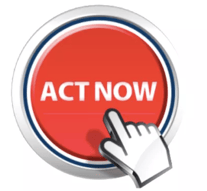 At KLA we’re on a mission to help local government staff and elected officials -- especially those focusing on sustainability and climate action -- up their communications and community outreach games in 2019. That’s why there is KLA Communications Boot Camp, a new series of blog posts, podcasts, guidebooks and trainings we will offer throughout the year focused on communications and community outreach skills.
At KLA we’re on a mission to help local government staff and elected officials -- especially those focusing on sustainability and climate action -- up their communications and community outreach games in 2019. That’s why there is KLA Communications Boot Camp, a new series of blog posts, podcasts, guidebooks and trainings we will offer throughout the year focused on communications and community outreach skills.
Let’s dive right in to Part 2: Write Winning Blog Posts. (Note: Part 1 -- Website Content that Works -- is available here.)
A blog is an excellent way to keep website content fresh, drive people to your site, amplify your work and seed social media posts. Your local government doesn’t have a blog? The guidance below also applies if you have the opportunity to contribute an article to a local media outlet or similar.

- Know your audience. As a local government, use what you know about your community to ensure the content aligns with their needs. If your IT department supports it, tap into Google Analytics and other tools to drill down even deeper.
- Start strong. Your headline and opening paragraph are critical to grabbing your readers' attention. Short, sweet, to the point and no “click bait” -- you want the post to deliver what you promise.
- Use active voice. Instead of writing “The goals were developed with the help of a community stakeholder group,” say “A community stakeholder group drove the development of the draft goals.” This reads better and tightens up the content. Here are more tips on switching from the passive to active voice.
- Make it easy for people to scan with their eyes. No one reads word-for-word anymore. In fact, visitors will only read about 20% of the text on the average page.
Use subheadings. This breaks up your content into scannable chunks and helps you organize -- and readers follow -- the content.
Use numbered or bulleted lists.Make good use of the bold and italic formatting options. While you don’t want a page that’s too busy, you can use these strategically to direct readers and maintain interest.
Use images. Break it up with relevant -- and whenever possible local (not stock) -- images. Here’s a good example of using images on a webpage from Orlando. For ADA compliance, Search Engine Optimization or SEO (here is Wikipedia’s explanation of SEO) and general best practice, make sure all images have Alt Text. If you’re not sure what that is, read about Alt Text here.
For ADA compliance, Search Engine Optimization or SEO (here is Wikipedia’s explanation of SEO) and general best practice, make sure all images have Alt Text. If you’re not sure what that is, read about Alt Text here. - Give the reader information they can use. Here is a KLA example of a 20-question branding exercise.
- Write a list. Listicles are fun to write and read. Here’s a KLA example, “6 Ways We Help You Meet Climate and Sustainability Goals”.

- Make a point. Don’t be afraid to include a one-sentence paragraph, and to put it in bold. If you have a point that is critical to make -- or a compelling quote from a relevant source that underscores your point -- let it stand alone.
- Show, don’t just tell. From photos to infographics, give them some eye candy.
These days if you have a smartphone, you’re a photographer. Read tips for taking the best photos on your phone.
If there is a video that covers your topic in a compelling way, embed that video on your blog (with appropriate attribution) so they can watch it as they read your post. Here’s an example where we have the Thrive Indianapolis video we produced as part of a blog post. - Get sensory. Appeal to all five senses with the words and descriptions you use. This post from HubSpot has some useful examples (see #6) that underscore the rule that “If your readers can see, hear, touch, smell, or taste your ideas, then they’ll be hooked on your content.”
- There is no hard and fast rule for length. The conventional wisdom argued for shorter blog posts of around 500 words per post. Research has shown that SEO results and user engagement actually improve when posts are 1,000+ words. This article takes a look at the pros and cons of short and long posts. We recommend thinking about your particular content and audience. If there is value in writing a longer post and can you keep readers engaged.
 If you can’t bear to part with your content yet you’re over 1,500 words, consider splitting it into a 2+ part series. Here’s a KLA example.
If you can’t bear to part with your content yet you’re over 1,500 words, consider splitting it into a 2+ part series. Here’s a KLA example. - Write like you talk. Blogging is different from an academic paper, report or newspaper article. Blogging is about community. There needs to be a conversational flow to your content. Read it aloud to yourself, a colleague or friend and see if it sounds natural or awkward.
 Use fresh language. Try not to repeat words too often. Consult an online tool like Power Thesaurus to find good alternatives.
Use fresh language. Try not to repeat words too often. Consult an online tool like Power Thesaurus to find good alternatives.- Short is sweet. Write short sentences, and cover only a single topic or thought in a sentence.
- Link to quality content. These can be internal links -- like other pages on your local government website -- or external, to local community groups, news media and other relevant resources.
 Ensure your use of links is ADA compliant. Check out these ADA compliant tips.
Ensure your use of links is ADA compliant. Check out these ADA compliant tips. - End with a call to action. You don’t want people to end by thinking “Now what?” If you just spent an entire blog post touting your local government’s pledge to increase acreage of and access to green space: send people to a survey to find out where people want more green space and what type; link to a draft map of where the city is focusing and ask people to check it out and share with their neighbors; offer to have a local government representative come talk to your neighborhood association or other organization; or share details for an upcoming public meeting.

- Give people an opportunity to participate. Allow people to join the conversation and share their stories and ideas through commenting or via social media. Consider including a short quiz or survey to add an interactive element. Be prepared to moderate and respond as needed.
- Make it easy to find. Be sure to use SEO tools like keywords, meta descriptions (the short snippet that shows up in search results) and more to ensure people find your posts. And of course actively promote it via social media, e-newsletters, and appropriate pages across the website (i.e. If your post addresses the implications of climate change on the local economy and jobs, there might be a good place on the Economic Development or Mayor’s webpages to link to it).
- Archive and repurpose! Don’t let all the time you spent writing and promoting your posts go to waste. Make sure all your previous posts are archived somewhere that people can find them. Pull out excerpts to use as needed with links back to the original post. If you wrote a post about changes to local energy efficiency opportunities, reuse that later for Energy Awareness Month/National Energy Efficiency Day in October.
You can check out our KLA blog to see some of these tips in action. Please share any additional tips or examples that you think would be useful by emailing annie@kimlundgrenassociates.com. And, if you haven’t done so already, download our Storytelling Guidebook which is a 4-step framework for turning your data into a compelling story.
![]()
If you missed it, circle back to the first part of our KLA Communications Boot Camp, Website Content that Works.
Stay tuned for what’s next in our Boot Camp (coming soon: using video, email marketing and social media). Make sure you’re signed up for our emails to get the latest:

